JAGUAR XJ 2004 X350 / 3.G Owners Manual
Manufacturer: JAGUAR, Model Year: 2004, Model line: XJ, Model: JAGUAR XJ 2004 X350 / 3.GPages: 227, PDF Size: 4.22 MB
Page 131 of 227
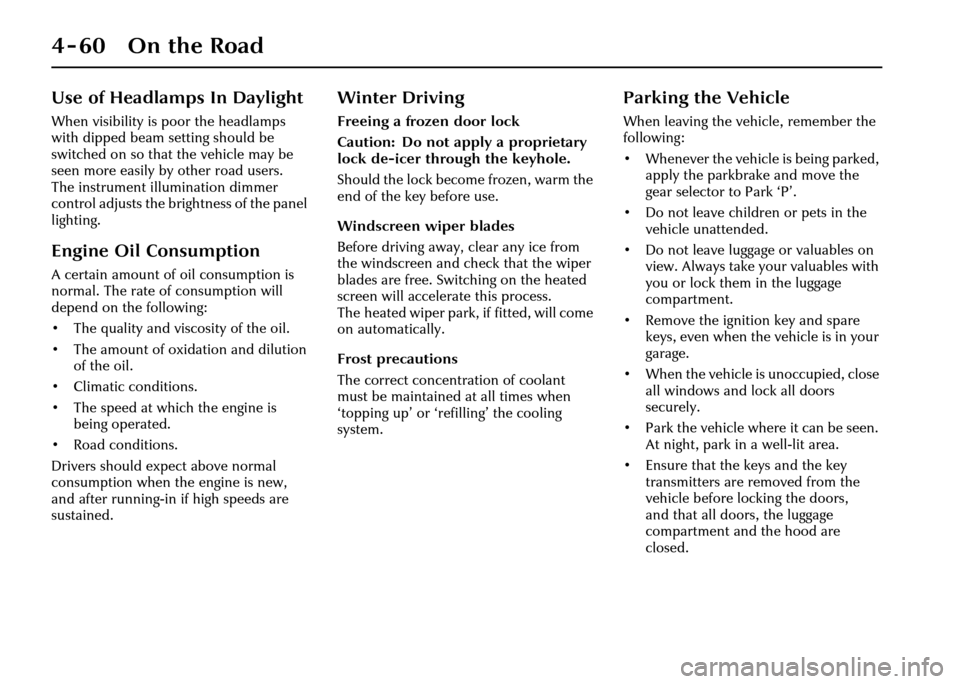
4-60 On the Road
Use of Headlamps In Daylight
When visibility is poor the headlamps
with dipped beam setting should be
switched on so that the vehicle may be
seen more easily by other road users.
The instrument illumination dimmer
control adjusts the brightness of the panel
lighting.
Engine Oil Consumption
A certain amount of oil consumption is
normal. The rate of consumption will
depend on the following:
• The quality and viscosity of the oil.
• The amount of oxidation and dilution of the oil.
• Climatic conditions.
• The speed at which the engine is being operated.
• Road conditions.
Drivers should expect above normal
consumption when the engine is new,
and after running-in if high speeds are
sustained.
Winter Driving
Freeing a frozen door lock
Caution: Do not ap ply a proprietary
lock de-icer through the keyhole.
Should the lock beco me frozen, warm the
end of the key before use.
Windscreen wiper blades
Before driving away, clear any ice from
the windscreen and check that the wiper
blades are free. Switching on the heated
screen will accelerate this process.
The heated wiper park, if fitted, will come
on automatically.
Frost precautions
The correct concentration of coolant
must be maintained at all times when
‘topping up’ or ‘refilling’ the cooling
system.
Parking the Vehicle
When leaving the vehicle, remember the
following:
• Whenever the vehicle is being parked, apply the parkbrake and move the
gear selector to Park ‘P’.
• Do not leave children or pets in the vehicle unattended.
• Do not leave luggage or valuables on view. Always take your valuables with
you or lock them in the luggage
compartment.
• Remove the ignition key and spare keys, even when the vehicle is in your
garage.
• When the vehicle is unoccupied, close
all windows and lock all doors
securely.
• Park the vehicle where it can be seen. At night, park in a well-lit area.
• Ensure that the keys and the key transmitters are removed from the
vehicle before locking the doors,
and that all doors, the luggage
compartment and the hood are
closed.
Page 132 of 227
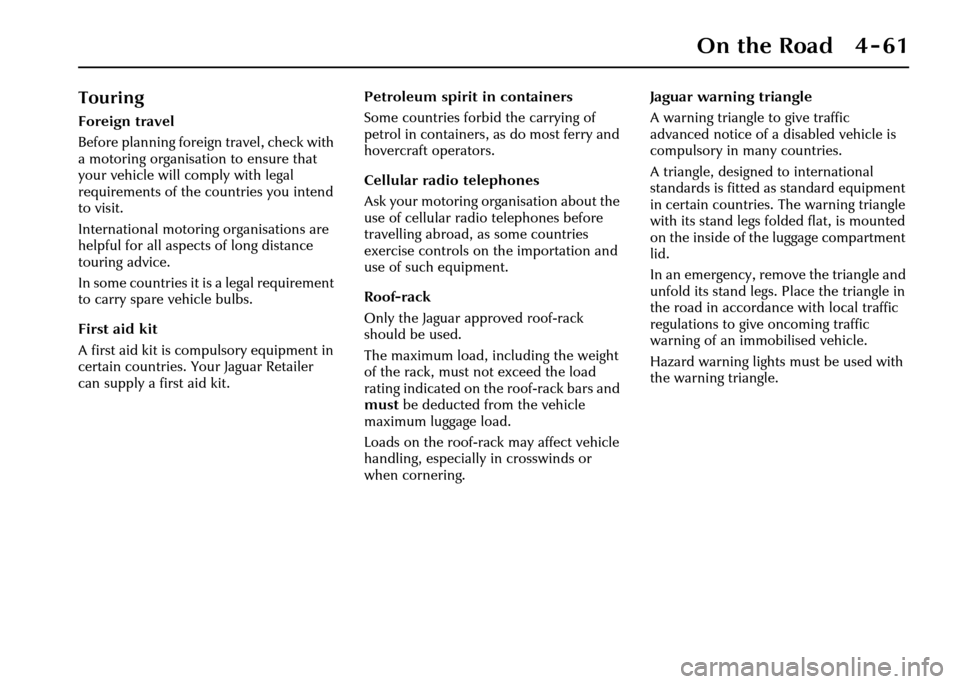
On the Road 4 - 61
Touring
Foreign travel
Before planning foreign travel, check with
a motoring organisation to ensure that
your vehicle will comply with legal
requirements of the countries you intend
to visit.
International motoring organisations are
helpful for all aspects of long distance
touring advice.
In some countries it is a legal requirement
to carry spare vehicle bulbs.
First aid kit
A first aid kit is compulsory equipment in
certain countries. Your Jaguar Retailer
can supply a first aid kit.Petroleum spirit in containers
Some countries forbid the carrying of
petrol in containers, as do most ferry and
hovercraft operators.
Cellular radio telephones
Ask your motoring organisation about the
use of cellular radio telephones before
travelling abroad, as some countries
exercise controls on the importation and
use of such equipment.
Roof-rack
Only the Jaguar approved roof-rack
should be used.
The maximum load, including the weight
of the rack, must not exceed the load
rating indicated on th
e roof-rack bars and
must be deducted from the vehicle
maximum luggage load.
Loads on the roof-rack may affect vehicle
handling, especially in crosswinds or
when cornering. Jaguar warning triangle
A warning triangle to give traffic
advanced notice of a disabled vehicle is
compulsory in many countries.
A triangle, designed to international
standards is fitted as standard equipment
in certain countries. The warning triangle
with its stand legs folded flat, is mounted
on the inside of the luggage compartment
lid.
In an emergency, remove the triangle and
unfold its stand legs. Place the triangle in
the road in accordance with local traffic
regulations to give oncoming traffic
warning of an im
mobilised vehicle.
Hazard warning lights must be used with
the warning triangle.
Page 133 of 227
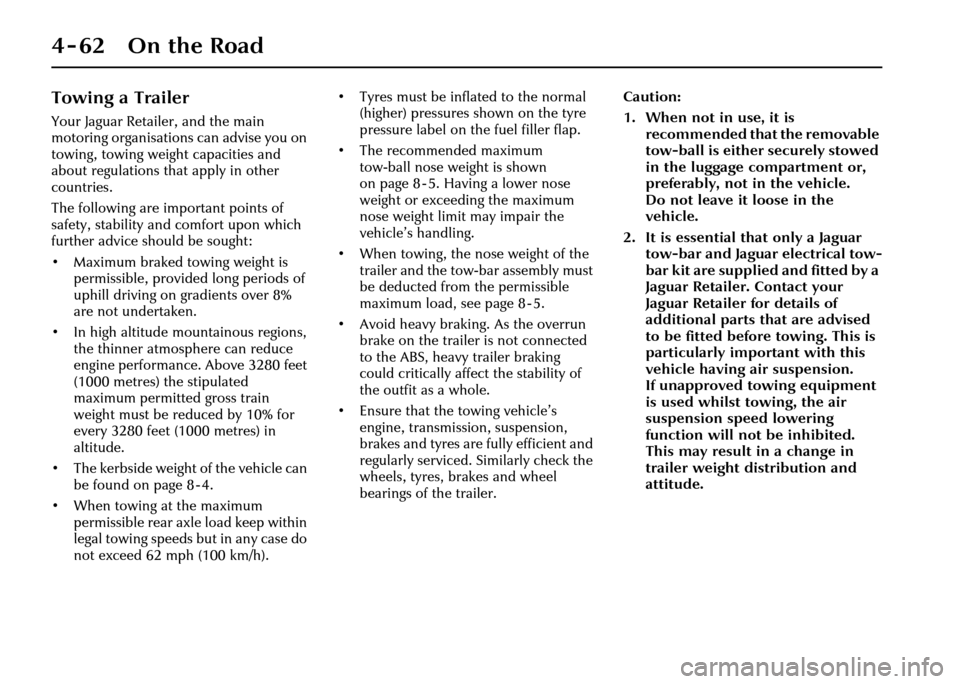
4-62 On the Road
Towing a Trailer
Your Jaguar Retailer, and the main
motoring organisations can advise you on
towing, towing weight capacities and
about regulations that apply in other
countries.
The following are important points of
safety, stability and comfort upon which
further advice should be sought:
• Maximum braked towing weight is permissible, provided long periods of
uphill driving on gradients over 8%
are not undertaken.
• In high altitude mountainous regions, the thinner atmosphere can reduce
engine performance. Above 3280 feet
(1000 metres) the stipulated
maximum permitted gross train
weight must be reduced by 10% for
every 3280 feet (1000 metres) in
altitude.
• The kerbside weight of the vehicle can be found on page 8 - 4.
• When towing at the maximum permissible rear axle load keep within
legal towing speeds but in any case do
not exceed 62 mph (100 km/h). • Tyres must be inflated to the normal
(higher) pressures shown on the tyre
pressure label on the fuel filler flap.
• The recommended maximum tow-ball nose weight is shown
on page 8 - 5. Having a lower nose
weight or exceeding the maximum
nose weight limit may impair the
vehicle’s handling.
• When towing, the nose weight of the trailer and the tow-bar assembly must
be deducted from the permissible
maximum load, see page 8 - 5.
• Avoid heavy braking. As the overrun brake on the traile r is not connected
to the ABS, heavy trailer braking
could critically affect the stability of
the outfit as a whole.
• Ensure that the towing vehicle’s engine, transmission, suspension,
brakes and tyres are fully efficient and
regularly serviced. Similarly check the
wheels, tyres, brakes and wheel
bearings of the trailer. Caution:
1. When not in use, it is
recommended that the removable
tow-ball is either securely stowed
in the luggage compartment or,
preferably, not in the vehicle.
Do not leave it loose in the
vehicle.
2. It is essential that only a Jaguar tow-bar and Jaguar electrical tow-
bar kit are supplied and fitted by a
Jaguar Retailer. Contact your
Jaguar Retailer for details of
additional parts that are advised
to be fitted before towing. This is
particularly important with this
vehicle having air suspension.
If unapproved towing equipment
is used whilst towing, the air
suspension speed lowering
function will not be inhibited.
This may result in a change in
trailer weight distribution and
attitude.
Page 134 of 227
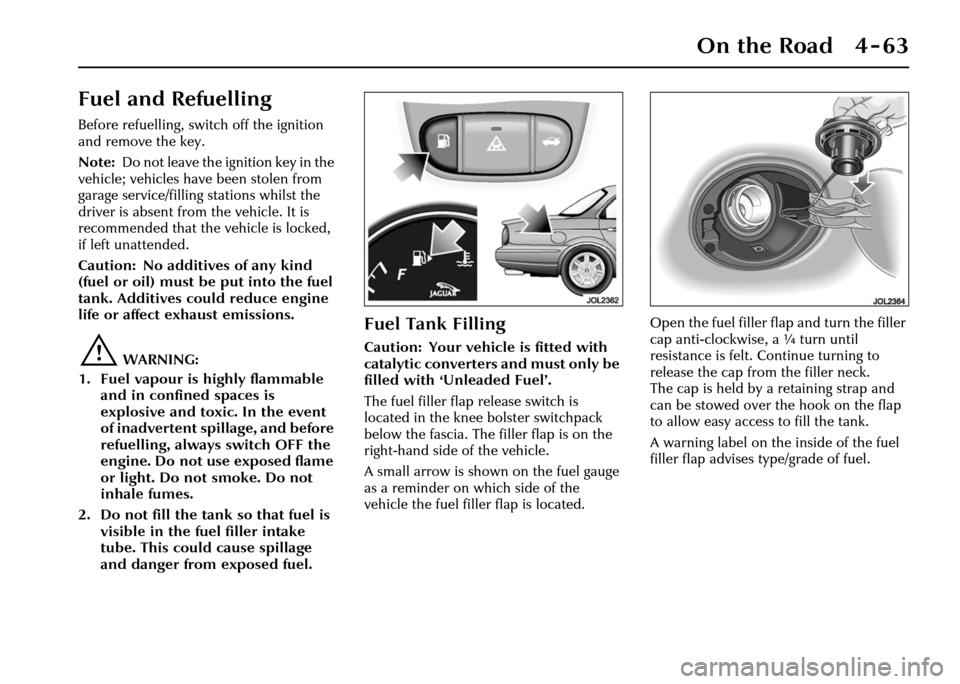
On the Road 4 - 63
Fuel and Refuelling
Before refuelling, switch off the ignition
and remove the key.
Note:Do not leave the ignition key in the
vehicle; vehicles have been stolen from
garage service/filling stations whilst the
driver is absent from the vehicle. It is
recommended that the vehicle is locked,
if left unattended.
Caution: No additives of any kind
(fuel or oil) must be put into the fuel
tank. Additives could reduce engine
life or affect exhaust emissions.
!WARNING:
1. Fuel vapour is highly flammable and in confined spaces is
explosive and toxic. In the event
of inadvertent spillage, and before
refuelling, always switch OFF the
engine. Do not use exposed flame
or light. Do not smoke. Do not
inhale fumes.
2. Do not fill the tank so that fuel is visible in the fuel filler intake
tube. This could cause spillage
and danger from exposed fuel.
Fuel Tank Filling
Caution: Your vehicle is fitted with
catalytic converters and must only be
filled with ‘Unleaded Fuel’.
The fuel filler flap release switch is
located in the knee bolster switchpack
below the fascia. The fi ller flap is on the
right-hand side of the vehicle.
A small arrow is shown on the fuel gauge
as a reminder on which side of the
vehicle the fuel filler flap is located. Open the fuel filler flap and turn the filler
cap anti-clockwise, a ¼ turn until
resistance is felt. Continue turning to
release the cap from the filler neck.
The cap is held by a retaining strap and
can be stowed over the hook on the flap
to allow easy access to fill the tank.
A warning label on the inside of the fuel
filler flap advises type/grade of fuel.
Page 135 of 227
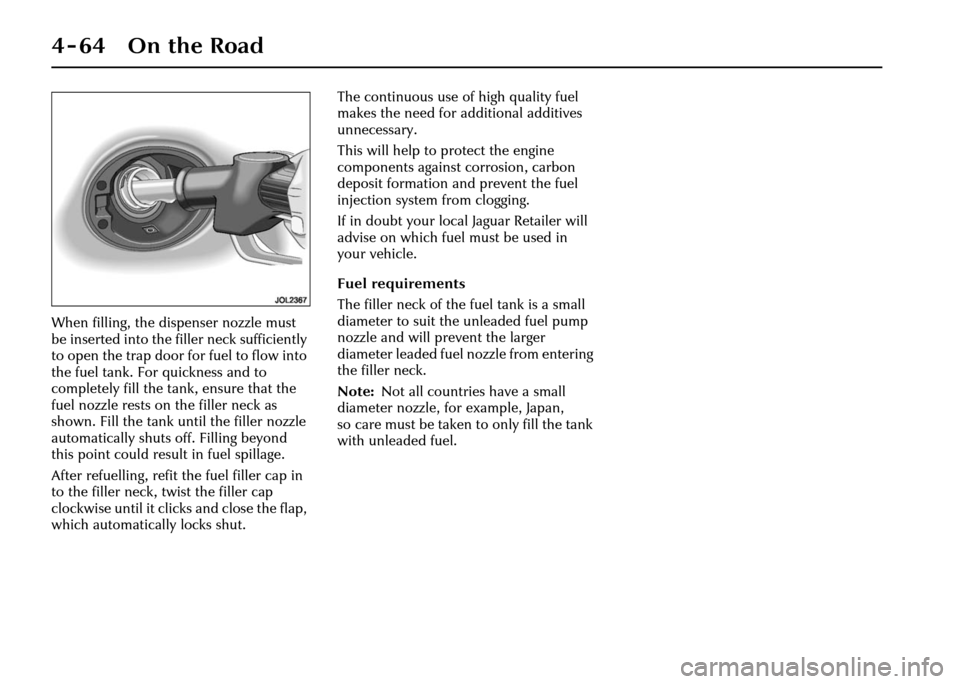
4-64 On the Road
When filling, the dispenser nozzle must
be inserted into the filler neck sufficiently
to open the trap door for fuel to flow into
the fuel tank. For quickness and to
completely fill the ta nk, ensure that the
fuel nozzle rests on the filler neck as
shown. Fill the tank until the filler nozzle
automatically shuts off. Filling beyond
this point could result in fuel spillage.
After refuelling, refit the fuel filler cap in
to the filler neck, twist the filler cap
clockwise until it clicks and close the flap,
which automatically locks shut. The continuous use of high quality fuel
makes the need for a
dditional additives
unnecessary.
This will help to protect the engine
components against corrosion, carbon
deposit formation and prevent the fuel
injection system from clogging.
If in doubt your local Jaguar Retailer will
advise on which fuel must be used in
your vehicle.
Fuel requirements
The filler neck of the fuel tank is a small
diameter to suit the unleaded fuel pump
nozzle and will prevent the larger
diameter leaded fuel nozzle from entering
the filler neck.
Note: Not all countries have a small
diameter nozzle, for example, Japan,
so care must be taken to only fill the tank
with unleaded fuel.
Page 136 of 227
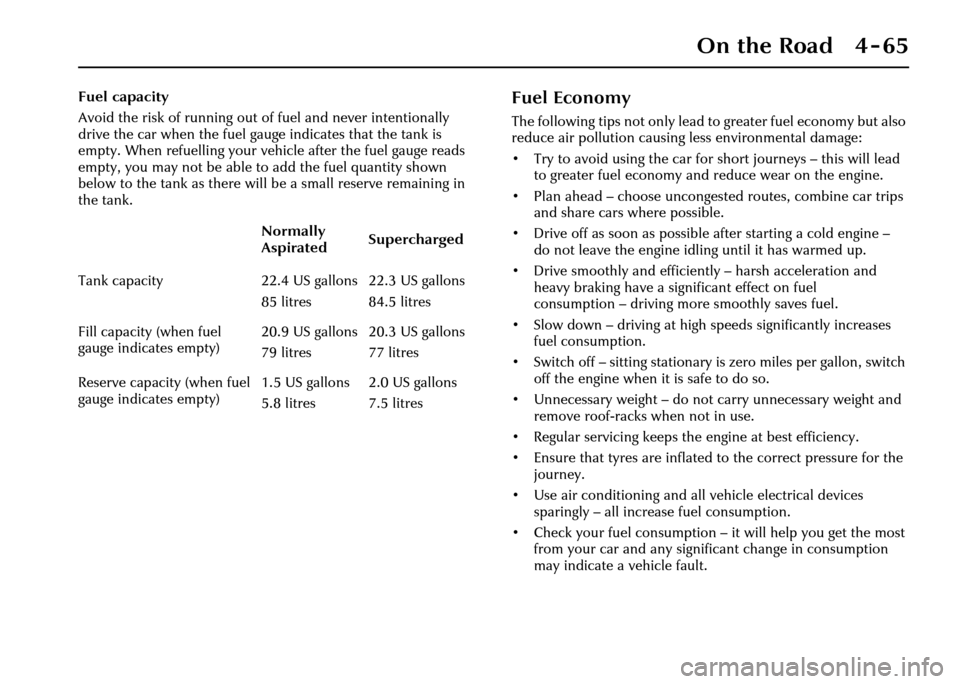
On the Road 4 - 65
Fuel capacity
Avoid the risk of running out of fuel and never intentionally
drive the car when the fuel gauge indicates that the tank is
empty. When refuelling your vehicle after the fuel gauge reads
empty, you may not be able to add the fuel quantity shown
below to the tank as there will be a small reserve remaining in
the tank.Fuel Economy
The following tips not only lead to greater fuel economy but also
reduce air pollution causing less environmental damage:
• Try to avoid using the car for short journeys – this will lead
to greater fuel economy and reduce wear on the engine.
• Plan ahead – choose uncongested routes, combine car trips and share cars where possible.
• Drive off as soon as possible after starting a cold engine – do not leave the engine idling until it has warmed up.
• Drive smoothly and efficiently – harsh acceleration and heavy braking have a significant effect on fuel
consumption – driving more smoothly saves fuel.
• Slow down – driving at high speeds significantly increases fuel consumption.
• Switch off – sitting stationary is zero miles per gallon, switch
off the engine when it is safe to do so.
• Unnecessary weight – do not carry unnecessary weight and remove roof-racks when not in use.
• Regular servicing keeps the engine at best efficiency.
• Ensure that tyres are inflated to the correct pressure for the journey.
• Use air conditioning and all vehicle electrical devices sparingly – all increase fuel consumption.
• Check your fuel consumption – it will help you get the most from your car and any significant change in consumption
may indicate a vehicle fault.
Normally
Aspirated
Supercharged
Tank capacity 22.4 US gallons
85 litres 22.3 US gallons
84.5 litres
Fill capacity (when fuel
gauge indicates empty) 20.9 US gallons
79 litres20.3 US gallons
77 litres
Reserve capacity (when fuel
gauge indicates empty) 1.5 US gallons
5.8 litres2.0 US gallons
7.5 litres
Page 137 of 227
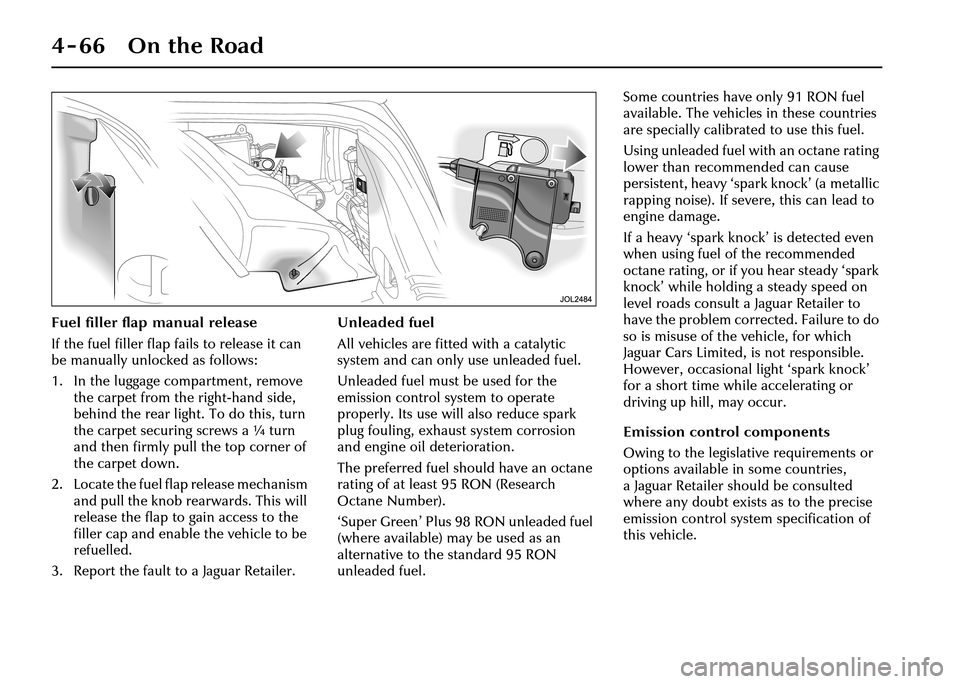
4-66 On the Road
Fuel filler flap manual release
If the fuel filler flap fails to release it can
be manually unlocked as follows:
1. In the luggage compartment, remove
the carpet from the right-hand side,
behind the rear light. To do this, turn
the carpet securing screws a ¼ turn
and then firmly pull the top corner of
the carpet down.
2. Locate the fuel flap release mechanism and pull the knob rearwards. This will
release the flap to gain access to the
filler cap and enable the vehicle to be
refuelled.
3. Report the fault to a Jaguar Retailer. Unleaded fuel
All vehicles are fitted with a catalytic
system and can only use unleaded fuel.
Unleaded fuel must be used for the
emission control system to operate
properly. Its use will also reduce spark
plug fouling, exhaust system corrosion
and engine oil deterioration.
The preferred fuel should have an octane
rating of at least 95 RON (Research
Octane Number).
‘Super Green’ Plus 98 RON unleaded fuel
(where available) may be used as an
alternative to the standard 95 RON
unleaded fuel. Some countries have only 91 RON fuel
available. The vehicles in these countries
are specially calibrated to use this fuel.
Using unleaded fuel with an octane rating
lower than recomm
ended can cause
persistent, heavy ‘spark knock’ (a metallic
rapping noise). If severe, this can lead to
engine damage.
If a heavy ‘spark knock’ is detected even
when using fuel of the recommended
octane rating, or if you hear steady ‘spark
knock’ while holding a steady speed on
level roads consult a Jaguar Retailer to
have the problem corrected. Failure to do
so is misuse of the vehicle, for which
Jaguar Cars Limited, is not responsible.
However, occasional light ‘spark knock’
for a short time while accelerating or
driving up hill, may occur.
Emission control components
Owing to the legislative requirements or
options available in some countries,
a Jaguar Retailer should be consulted
where any doubt exists as to the precise
emission control system specification of
this vehicle.
Page 138 of 227
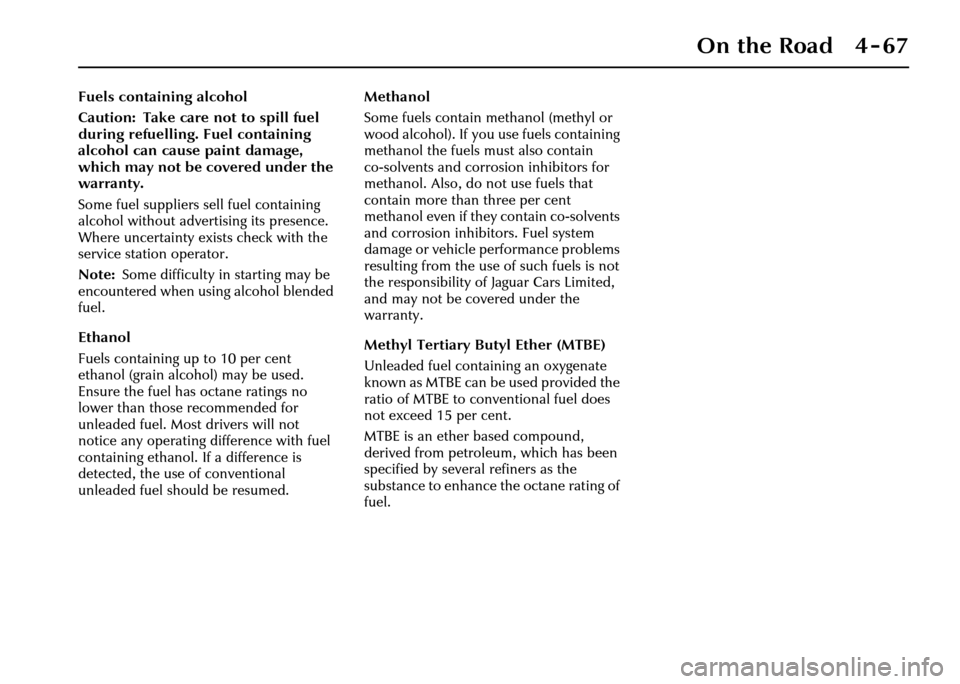
On the Road 4 - 67
Fuels containing alcohol
Caution: Take care not to spill fuel
during refuelling. Fuel containing
alcohol can cause paint damage,
which may not be covered under the
warranty.
Some fuel suppliers sell fuel containing
alcohol without advertising its presence.
Where uncertainty exists check with the
service station operator.
Note: Some difficulty in starting may be
encountered when using alcohol blended
fuel.
Ethanol
Fuels containing up to 10 per cent
ethanol (grain alcohol) may be used.
Ensure the fuel has octane ratings no
lower than those recommended for
unleaded fuel. Most drivers will not
notice any operating difference with fuel
containing ethanol. If a difference is
detected, the use of conventional
unleaded fuel should be resumed. Methanol
Some fuels contain methanol (methyl or
wood alcohol). If you use fuels containing
methanol the fuels must also contain
co-solvents and corrosion inhibitors for
methanol. Also, do not use fuels that
contain more than three per cent
methanol even if they
contain co-solvents
and corrosion inhibitors. Fuel system
damage or vehicle performance problems
resulting from the use of such fuels is not
the responsibility of Jaguar Cars Limited,
and may not be covered under the
warranty.
Methyl Tertiary Butyl Ether (MTBE)
Unleaded fuel containing an oxygenate
known as MTBE can be used provided the
ratio of MTBE to conventional fuel does
not exceed 15 per cent.
MTBE is an ether based compound,
derived from petroleum, which has been
specified by several refiners as the
substance to enhance the octane rating of
fuel.
Page 139 of 227
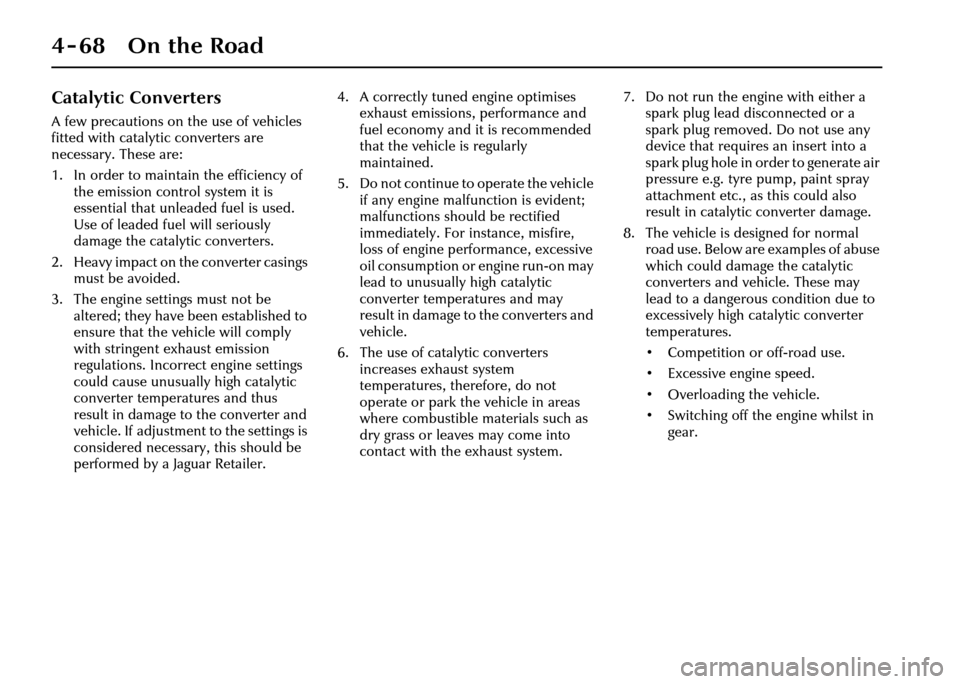
4-68 On the Road
Catalytic Converters
A few precautions on the use of vehicles
fitted with catalytic converters are
necessary. These are:
1. In order to maintain the efficiency of the emission control system it is
essential that unleaded fuel is used.
Use of leaded fuel will seriously
damage the catalytic converters.
2. Heavy impact on the converter casings must be avoided.
3. The engine settings must not be altered; they have been established to
ensure that the vehicle will comply
with stringent exhaust emission
regulations. Incorrect engine settings
could cause unusually high catalytic
converter temperatures and thus
result in damage to the converter and
vehicle. If adjustment to the settings is
considered necessary, this should be
performed by a Jaguar Retailer. 4. A correctly tuned engine optimises
exhaust emissions, performance and
fuel economy and it is recommended
that the vehicle is regularly
maintained.
5. Do not continue to operate the vehicle if any engine malfunction is evident;
malfunctions should be rectified
immediately. For instance, misfire,
loss of engine performance, excessive
oil consumption or engine run-on may
lead to unusually high catalytic
converter temperatures and may
result in damage to the converters and
vehicle.
6. The use of catalytic converters increases exhaust system
temperatures, therefore, do not
operate or park the vehicle in areas
where combustible materials such as
dry grass or leaves may come into
contact with the exhaust system. 7. Do not run the engine with either a
spark plug lead disconnected or a
spark plug removed. Do not use any
device that requires an insert into a
spark plug hole in order to generate air
pressure e.g. tyre pump, paint spray
attachment etc., as this could also
result in catalyti c converter damage.
8. The vehicle is designed for normal road use. Below are examples of abuse
which could damage the catalytic
converters and vehicle. These may
lead to a dangerous condition due to
excessively high catalytic converter
temperatures.
• Competition or off-road use.
• Excessive engine speed.
• Overloading the vehicle.
• Switching off the engine whilst in gear.
Page 140 of 227
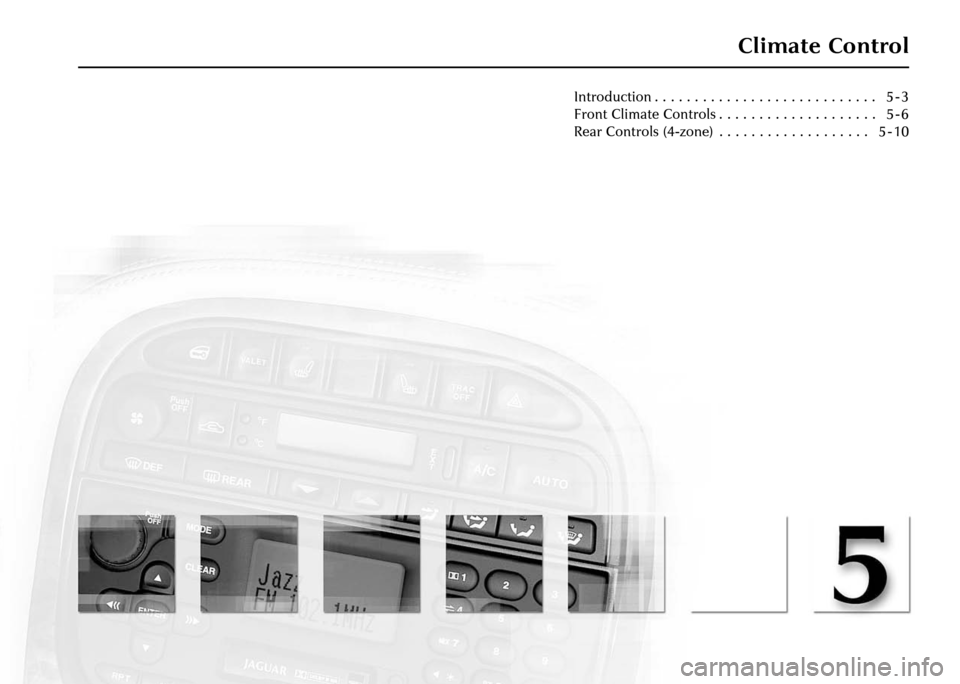
Climate Control
Introduction . . . . . . . . . . . . . . . . . . . . . . . . . . . . 5 - 3
Front Climate Controls . . . . . . . . . . . . . . . . . . . . 5 - 6
Rear Controls (4-zone) . . . . . . . . . . . . . . . . . . . 5 - 10